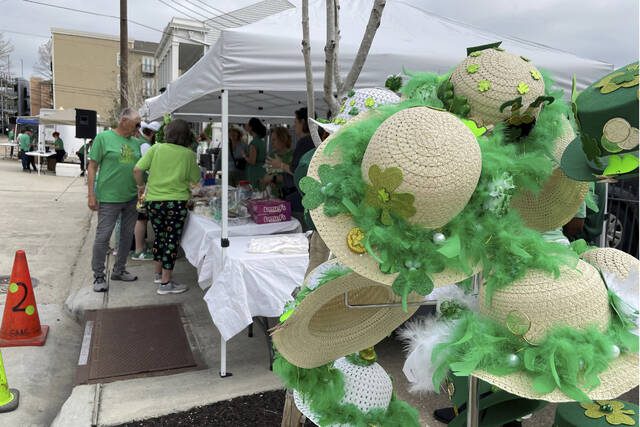NEW ORLEANS — The large old city hall with columns was created by an architect from Ireland. A district near the docks is still called the Irish Channel. Landmark towers and spires of Catholic churches built for Irish immigrants can be seen in the skyline.
New Orleans is famous for a culture that developed from early French and Spanish settlement, Caribbean trade, and the legacies of enslaved Africans. However, immigrants from various countries also influenced New Orleans’ art, architecture, food, and music. March brings an annual focus on the Irish, with St. Patrick’s Day celebrations that include shamrock-themed block parties and neighborhood parades.
“If you look back on the Irish history in New Orleans or the Irish politics in New Orleans, a lot of our mayors and representatives and council people were from Irish descent,” said Ronnie Burke, the grand marshal of this weekend’s Irish Channel parade.
He held a string of rosary beads made of marble from Connemara in Ireland’s County Galway. His family emigrated from there five generations ago to escape the Great Hunger, which set off a wave of Irish migration in the 19th century.
He was among scores of green-clad New Orleans residents gathered at a park near the Mississippi River on Thursday during an Irish-themed block party and fundraiser for St. Michael, a school serving students with learning disabilities. The event also served as something of a reunion for former Irish Channel residents who attended a Catholic school in the area. And it was a prelude to this weekend’s parades in and around New Orleans.
Irish myths and legends are plentiful in the city, especially at this time of year.
A lot of it focuses on the work of Irish immigrants in the digging of the New Basin Canal in the early 1800s, part of a national wave of infrastructure improvements that attracted Irish immigrant workers. The difficulties the New Basin laborers faced — aside from hard work, there was a deadly cholera outbreak — are sources of pride among the city’s Irish.
The canal eventually became outdated and was filled in decades ago, but a park on a part of the reclaimed land, indicated by a 7-foot (2.1-meter) marble Celtic cross, honors the memory of the laborers.
The difficult lives of Irish laborers gave rise to a St. Patrick’s Day tradition unique to New Orleans: Float riders in the annual Irish Channel parade throw cabbages and potatoes to the people on the street, an Irish American variation of the Mardi Gras custom of throwing strings of beads and other favors to revelers.
“It’s unique to New Orleans, and it’s unique within New Orleans,” said Laura Kelley, an adjunct professor in Tulane University’s history department and author of the book “The Irish in New Orleans.” The tradition dates to the 1940s, she said.
“The Irish Channel was a real working, working-class neighborhood. And there were tough times — we’re coming out of the Great Depression,” she said. “It’s a way that you can give food to the people in your neighborhood and give it freely and equally and, well, it’s a face-saving measure.”
There has been Irish immigration to New Orleans since the early days of the city, when it was under French and later Spanish control, according to Kelley. The improvements in infrastructure and the famine brought more Irish immigrants, and by 1850, about a quarter of the city's population was Irish, she said.
"Per person, the Irish population in New Orleans was higher than in Philadelphia, Baltimore, Chicago, and Boston," Kelley said. "It was higher than anywhere else except New York City."
However, even the Irish are sometimes surprised by the strong Irish American culture in New Orleans. Sean Kennedy, who works as an accountant, came from Ireland in 1991. He didn't plan to stay, but he has been in New Orleans ever since and now owns an Irish bar.
Kelley, who has Irish ancestry, didn't know about the city's Irish heritage when she came to work on her doctorate about 30 years ago. She had a conversation with a cab driver and, because of his accent, thought he was from New York, not realizing that the city's way of speaking, influenced by Irish, Italian, and German immigrants, among others, often sounds more like the Northeast than the Old South.
"I was completely puzzled because he sounded like he was from New York City," Kelley said. "And here he's telling me that he has never left New Orleans. And it was the first time I heard about the Irish Channel."
But Bethany Brinkman has long appreciated the Irish influence. At Thursday's block party for St. Michael, she mentioned that her great-grandparents had immigrated from Ireland to New Orleans. She also remembered her grandfather singing Irish lullabies.
"He would speak with an Irish accent," she said, "that he learned from his grandparents."



